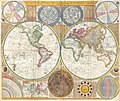Fail:1794 Samuel Dunn Wall Map of the World in Hemispheres - Geographicus - World2-dunn-1794.jpg

Necen ezikacundan suruz': 712 × 600 piksel'ad. Toine laskendad: 285 × 240 piksel'ad | 570 × 480 piksel'ad | 912 × 768 piksel'ad | 1216 × 1024 piksel'ad | 2431 × 2048 piksel'ad | 6000 × 5054 piksel'ad.
Originaline fail (6000 × 5054 piksel'ad, failan suruz': 8,92 mb, MIME-tip: image/jpeg)
Failan istorii
Paina päiväle/aigale, miše nägištada, mitte fail oli sil aigal.
| Päiv/Aig | Kuvaine | Suruded | Kävutai | Kirjutez | |
|---|---|---|---|---|---|
| nügüdläine | 1. Kezaku 2012, kell 23:01 |  | 6000 × 5054 (8,92 mb) | Brandmeister~commonswiki | Reverted to version as of 04:17, 23 March 2011 |
| 19. Semendku 2012, kell 19:15 |  | 6000 × 5054 (27,38 mb) | Brandmeister~commonswiki | contrast | |
| 23. Keväz’ku 2011, kell 07:17 |  | 6000 × 5054 (8,92 mb) | BotMultichillT | {{subst:User:Multichill/Geographicus |link=http://www.geographicus.com/P/AntiqueMap/World2-dunn-1794 |product_name=1794 Samuel Dunn Wall Map of the World in Hemispheres |map_title=A General Map of the World, or Terraqueouis Globe with all the New Discover |
Failan kävutamine
Nece lehtpol' kävutab necidä failad:
Failan leved kävutamine
Nene toižed wiki-lehtpoled kävutaba necidä failad:
- Kävutamine alt.wikipedia.org
- Kävutamine ar.wikipedia.org
- Kävutamine av.wikipedia.org
- Kävutamine br.wiktionary.org
- Kävutamine ckb.wikipedia.org
- Kävutamine cv.wikipedia.org
- Kävutamine de.wikipedia.org
- Kävutamine en.wikipedia.org
- Early world maps
- History of cartography
- Southern Ocean
- Samuel Dunn (mathematician)
- Wikipedia:Featured picture candidates/1794 Samuel Dunn Map
- A General Map of the World, or Terraqueous Globe
- Wikipedia:Featured picture candidates/June-2012
- User:Cruickshanks/sandbox2
- Wikipedia:Featured picture candidates/March-2014
- Wikipedia:Featured picture candidates/1794 Samuel Dunn Wall Map of the World in Hemispheres - Geographicus - World2-dunn-1794.jpg (review)
- User:Setvina/be bold
- Portal:Maps
- User:Sarangem
- User:Jacobwilder427
- Kävutamine en.wiktionary.org
- Kävutamine eo.wikipedia.org
- Kävutamine et.wikipedia.org
- Kävutamine eu.wikipedia.org
- Kävutamine fa.wikipedia.org
- ویکیپدیا:نگارههای برگزیده/نقشه
- ویکیپدیا:گزیدن نگاره برگزیده/ژوئن-۲۰۱۲
- نقشه ساموئل دان
- ویکیپدیا:گزیدن نگاره برگزیده/1794 Samuel Dunn Wall Map of the World in Hemispheres - Geographicus - World2-dunn-1794.jpg
- ویکیپدیا:نگاره روز/اکتبر ۲۰۱۲
- الگو:نر/2012-10-03
- الگو:نر محافظت شده/2012-10-03
- بحث کاربر:Alborzagros/بایگانی ۷
- Kävutamine fr.wikipedia.org
- Kävutamine fr.wikiversity.org
- Kävutamine gl.wikipedia.org
- Kävutamine hu.wikipedia.org
- Kävutamine hy.wikipedia.org
Kaculevenzoitud kävutamine neciš failas.

